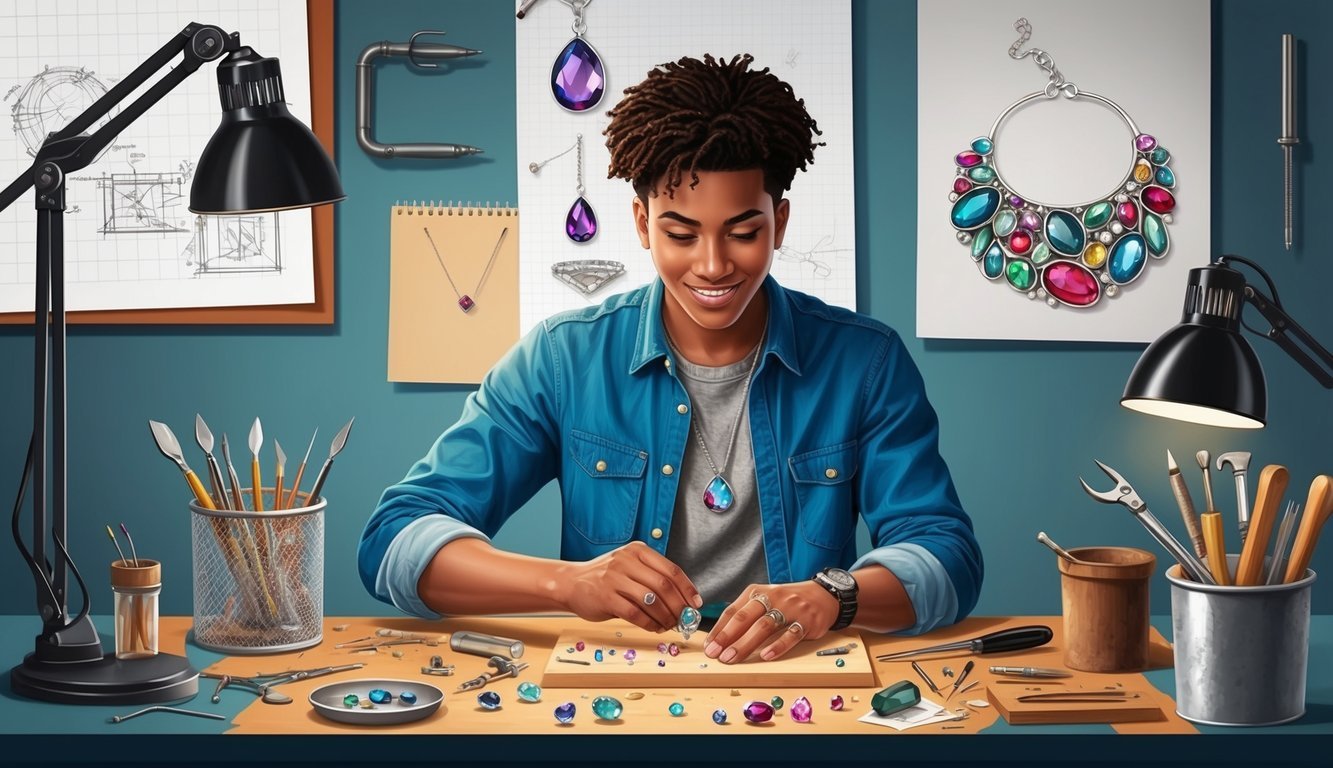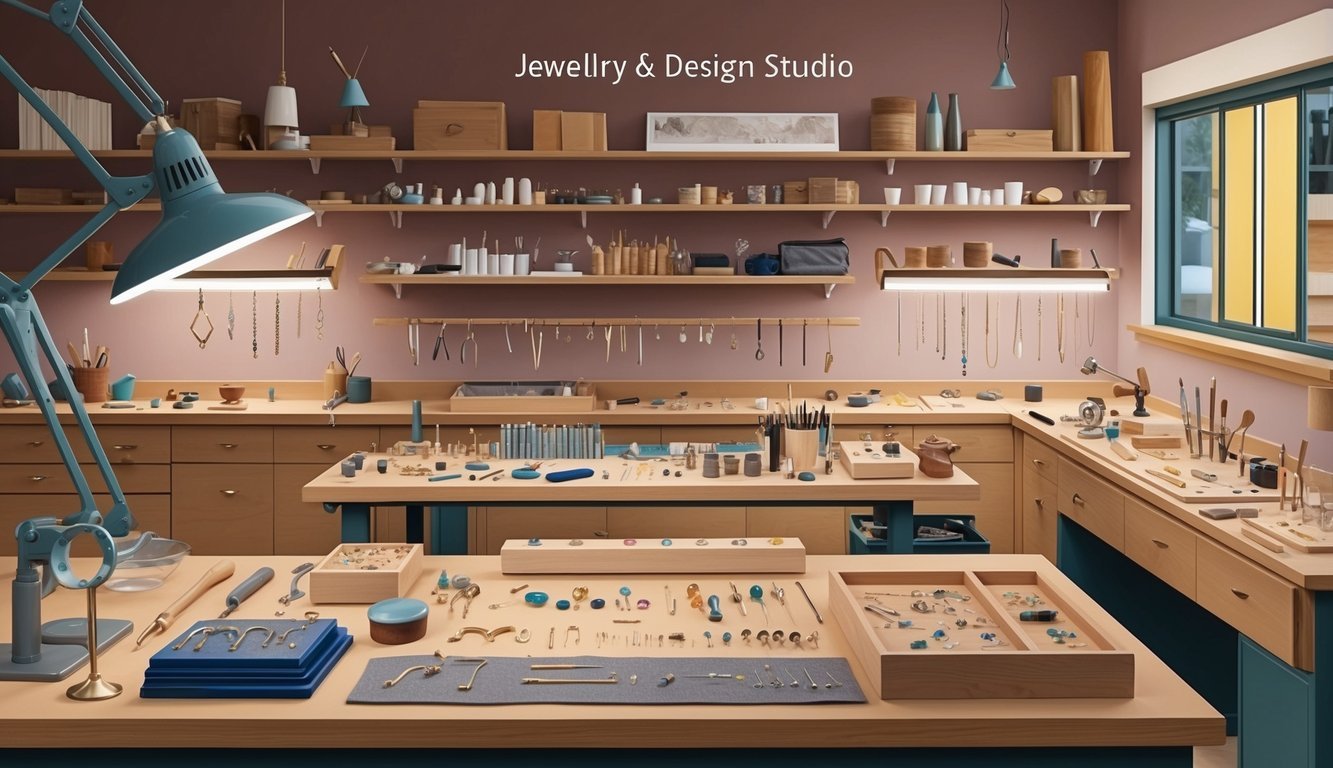Ever thought about crafting your own jewelry? Learning jewelry design can be a blast, and it’s a fantastic way to bring your creative ideas to life, whether you want to wear your creations or sell them.
There’s something incredibly satisfying about turning your thoughts into beautiful pieces that catch the eye.

If you’re eager to dive into jewelry design, you’ve got plenty of options.
You can find in-person or online classes to suit your style. Some of the best courses teach you how to sketch your designs, work with metals, and set stones—skills that help you create truly unique and eye-catching jewelry pieces.
1) Jewelry Design Essentials at New York Institute of Art and Design
Want to learn jewelry design from the comfort of your home? Check out the online jewelry design course at the New York Institute of Art and Design.
This one’s perfect for beginners or anyone looking to up their jewelry game.
You’ll kick things off with the basics—think color theory and composition.
These tidbits will help you whip up fabulous pieces that people can’t resist.
You’ll also dive into some nifty techniques, from jump rings to right angle weaves, plus French wire transitions and Danish clusters.
And let’s not forget the business side of things! The course will teach you how to package and market your jewelry too, which is super important if you plan to sell.
What’s great is the course’s flexibility—you can start whenever you want and work at your own pace.
No pressure, no race against deadlines.
By the end of it, you’ll have the skills to turn your jewelry ideas into real-life creations and know how to market them.
It’s a full package for anyone ready to jump into jewelry design.
2) Introduction to Jewelry Design by Coursera

Ready to learn jewelry design while still in your PJs? Coursera offers a fantastic Introduction to Jewelry Design course, perfect for beginners.
You’ll kick off with essential design principles, including color theory and typography—totally useful for creating those eye-catching jewelry pieces.
Plus, you’ll explore digital media, learning to use software that brings your designs to life.
It’s like peeking behind the curtain of professional tools that help you craft stunning visuals!
One cool bonus? This course emphasizes user experience (UX) design, showing you how to craft jewelry that’s not only pretty but comfortable and practical too.
By the end, you should have a solid foundation in jewelry design and be primed to start creating your unique pieces.
Plus, you’ll even get a certificate to showcase your new skills.
How’s that for motivation?
And remember, practice makes… well, not perfect, but definitely better! Don’t shy away from experimenting with your newfound skills.
3) The Soul of Jewelry Design by Central Saint Martins
If you’re dreaming of studying jewelry design at one of the best schools out there, look no further than the BA (Hons) Jewelry Design program at Central Saint Martins in London.
This course is all about diving deep into the art of jewelry making.
You’ll get hands-on experience with a variety of materials and techniques—everything from traditional metals to the latest technology.
The program encourages you to think outside the box and breathe life into fresh ideas.
It’s not just about churning out pretty designs; it’s about telling compelling stories through your creations.
Central Saint Martins is renowned for shaping top designers, and you’ll find yourself surrounded by creative individuals who inspire you to elevate your craft.
Plus, there’s an annual exhibition where you can flaunt your best pieces and catch the eye of industry pros—definitely a boost for any budding designer.
By the time you wrap up this program, you’ll not only have an impressive portfolio but also the skills needed to make a splash in the jewelry world.
If you’re really serious about jewelry design, this could be your golden ticket.
4) Jewelry Design Certificate Program at GIA

Eager to jumpstart your jewelry career? The Jewelry Design Certificate Program at GIA is a fantastic option!
You’ll get to brainstorm creative design ideas and turn them into stunning jewelry.
From drawing by hand to understanding the basics of jewelry engineering, this program has you covered.
You’ll learn how to sketch different shapes and textures for metals, as well as how to illustrate gems, pearls, and various colored metals.
It’s kind of like being a regular artist, but for jewelry—which is pretty darn cool!
And the cherry on top? You don’t need any previous experience to enroll.
Just bring your creativity and passion for jewelry; GIA will handle the rest.
By the time you finish, you’ll have a gorgeous portfolio to show potential employers or clients.
Who wouldn’t want to showcase their skills like that?
Benefits of Taking Jewelry Design Courses
Let’s be real: jewelry design courses can take your creative skills up a notch and help you get familiar with different materials and tools.
They’re all about turning your vivid ideas into beautiful jewelry art that you can wear or sell.
Developing Creative Skills
By taking jewelry design courses, you’ll really channel your creativity.
You’ll learn to sketch your ideas and bring them to life.
Plus, these classes often cover different styles and trends in the jewelry business.
You’ll practice various drawing techniques, like shading and illustrating shapes, which come in handy.
Some courses include training in digital design tools too.
In the end, you’ll have a portfolio packed with your work.
That’s super helpful if you’re aiming to start a jewelry business or apply for jobs in the industry.
Understanding Materials and Tools
Hands-on experience is where it’s at! During these courses, you’ll get to work directly with jewelry-making materials, understanding different metals, gems, and all sorts of materials used in this craft.
You’ll learn techniques like metal fabrication and stone setting too, discovering which tools are best for various tasks.
Some courses even introduce you to new materials—like resin—that can help you create truly unique pieces.
You’ll uncover things like:
- Different types of metals and their properties,
- Gemstone identification and grading,
- Tools for cutting, shaping, and polishing.
This knowledge will empower you to select the right materials for your designs while ensuring you work safely.
Essential Techniques in Jewelry Design

Jewelry design is a blend of art and craft, utilizing both traditional methods and modern techniques to create stunning pieces.
Here’s a quick look at two essential parts of the process.
Sketching and Rendering
Sketching is your first step in making ideas come alive on paper.
Begin with simple shapes and gradually add more details.
Grab pencils for basic outlines, then use markers or colored pencils to add textures and highlights.
Getting comfortable with sketching different gems and metal finishes is key—this helps you visualize how your jewelry will look. Learn to draw faceted gems and pearls as part of your designs for an added touch of realism.
Try out different perspectives—draw your piece from the front, side, and top.
This way, you get a comprehensive view of your design.
3D Modeling and Digital Tools
3D modeling can really elevate your designs.
It allows you to see your jewelry from all angles and makes it easier to tweak things.
You can use software to create detailed 3D models that bring your ideas to life.
With 3D printing, you can even create a test model of your piece, helping you get a real feel for the fit and weight before making the actual item.
Plus, digital tools come in handy when it comes to presenting your designs.
You can create lifelike images to impress clients or bolster your portfolio.
Career Opportunities in Jewelry Design

Jewelry design is packed with exciting opportunities for those who crave creativity.
With the right skills and a dash of determination, you can turn your passion into a fulfilling career.
Becoming a Professional Designer
If you have your sights set on working for big brands, many companies look for in-house designers.
You’d be responsible for creating new collections and refreshing classic styles.
A day in that role might involve sketching ideas, selecting materials, and collaborating with craftspeople.
Some designers focus on custom pieces for clients, crafting one-of-a-kind jewelry that tells a unique story.
You’ll sit down with customers to understand their vision and then bring that to life through your stunning designs.
Looking to enhance your marketability? Check out Jewelry Design & Technology programs that teach you the vital tools of the trade, including computer-aided design (CAD) software—essential in today’s tech-savvy industry.
Freelancing Prospects
Freelancing might just be your jam, giving you the freedom to be your own boss.
You can work from anywhere, set your hours, and still create beautiful pieces.
Many designers kick off their careers by selling on sites like Etsy or at local craft fairs.
In the freelance world, you wear a lot of hats—designer, marketer, and customer service rep all rolled into one.
Sure, it can be a bit overwhelming at times, but the rewards can be incredible.
Building a strong portfolio is key.
Consider enrolling in a Jewelry Design Certificate program that can help you sharpen your skills and create eye-catching pieces that attract clients.
Frequently Asked Questions

If you’re pondering over a jewelry design education, there are various paths you can take.
Let’s break down some common questions.
What degree do you need to be a jewelry designer?
You don’t necessarily need a degree to step into jewelry design.
Many people get started with a high school diploma and learn through hands-on experience.
Some opt for certificates in jewelry design from specialized schools, while others pursue a bachelor’s degree in fine arts or design.
Which course is best for jewelry design?
The best course for you depends on what you’re aiming for.
If you’re just starting out, the Jewelry Design Essentials at New York Institute of Art and Design is a solid choice.
More experienced designers might prefer the Jewelry Design Certificate Program at GIA.
What qualifications do I need for jewelry design?
First and foremost, you’ll need creativity and artistic flair.
Understanding gemstones, metals, and design principles is a must, as well.
Many designers hold certificates or degrees in jewelry design, and experience with CAD software is often a requirement for jobs.
How long does it take to learn CAD in jewelry design?
Getting a handle on the basics of CAD for jewelry design can take just a few months.
Mastering it often requires about 6 to 12 months of regular practice.
Many jewelry design programs incorporate CAD training into their curriculum.
What are the top rated jewelry design schools in Europe?
Central Saint Martins in London definitely tops the list.
They’re known for their The Soul of Jewelry Design course.
Other fantastic schools include Alchimia Contemporary Jewellery School in Italy and École de la Bijouterie-Joaillerie in France.
Are there any highly recommended jewelry design courses I can take online?
Absolutely! You’ve got a wealth of online options to choose from.
For instance, Coursera offers a popular course called Introduction to Jewelry Design.
Additionally, you can explore the Jewelry Design certificate course at GIA online.
And let’s not forget about platforms like Domestika that provide flexible learning courses beloved by many designers.

